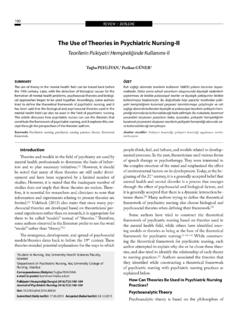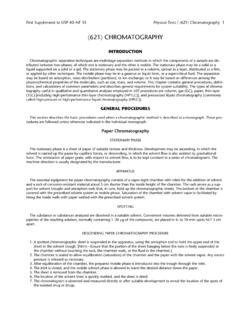Transcription of Separation techniques: Chromatography
1 North Clin Istanbul 2016;3(2):156 60doi: techniques: ChromatographyOzlem CoskunDepartment of Biophysics, Canakkale Onsekiz Mart University, Canakkale, TurkeyABSTRACTC hromatography is an important biophysical technique that enables the Separation , identification, and purification of the components of a mixture for qualitative and quantitative analysis. Proteins can be purified based on char-acteristics such as size and shape, total charge, hydrophobic groups present on the surface, and binding capacity with the stationary phase. Four Separation techniques based on molecular characteristics and interaction type use mechanisms of ion exchange, surface adsorption, partition, and size exclusion. Other Chromatography techniques are based on the stationary bed, including column, thin layer, and paper Chromatography .
2 Column chromatogra-phy is one of the most common methods of protein : Chromatography ; column Chromatography ; protein is based on the principle where molecules in mixture applied onto the surface or into the solid, and fluid stationary phase (stable phase) is separating from each other while moving with the aid of a mobile phase. The factors effective on this Separation process include molecular charac-teristics related to adsorption ( liquid -solid), parti-tion ( liquid -solid), and affinity or differences among their molecular weights [1, 2]. Because of these dif-ferences, some components of the mixture stay lon-ger in the stationary phase, and they move slowly in the Chromatography system, while others pass rapid-ly into mobile phase, and leave the system faster [3].Based on this approach three components form the basis of the Chromatography technique .
3 Stationary phase: This phase is always composed of a solid phase or a layer of a liquid adsorbed on the surface a solid support . Mobile phase: This phase is always composed of liquid or a gaseous component. Separated moleculesThe type of interaction between stationary phase, mobile phase, and substances contained in the mix-ture is the basic component effective on Separation of molecules from each other. Chromatography methods based on partition are very effective on Separation , and identification of small molecules as amino acids, carbohydrates, and fatty acids. Howev-er, affinity chromatographies (ie. ion-exchange chro-matography) are more effective in the Separation of macromolecules as nucleic acids, and proteins. Paper Chromatography is used in the Separation of pro-teins, and in studies related to protein synthesis; gas- liquid Chromatography is utilized in the Separation of alcohol, esther, lipid, and amino groups, and ob-servation of enzymatic interactions, while molecu-Received: February 17, 2016 Accepted: October 01, 2016 Correspondence: Dr.
4 Ozlem COSKUN. Canakkale Onsekiz Mart Universitesi Tip Fakultesi, Terzioglu Yerleskesi, Dekanlik Binasi, Biyofizik Anabilim Dali, Canakkale, : +90 286 - 218 00 18-2300 e-mail: Copyright 2016 by Istanbul Northern Anatolian Association of Public Hospitals - Available online at Review BIOCHEMISTRY lar-sieve Chromatography is employed especially for the determination of molecular weights of proteins. Agarose-gel Chromatography is used for the purifi-cation of RNA, DNA particles, and viruses [4].Stationary phase in Chromatography , is a solid phase or a liquid phase coated on the surface of a solid phase. Mobile phase flowing over the station-ary phase is a gaseous or liquid phase. If mobile phase is liquid it is termed as liquid chromatogra-phy (LC), and if it is gas then it is called gas chro-matography (GC).
5 Gas Chromatography is applied for gases, and mixtures of volatile liquids, and solid material. liquid Chromatography is used especially for thermal unstable, and non-volatile samples [5].The purpose of applying Chromatography which is used as a method of quantitative analysis apart from its Separation , is to achive a satisfactory sepa-ration within a suitable timeinterval. Various chro-matography methods have been developed to that end. Some of them include column chromatog-raphy, thin-layer Chromatography (TLC), paper Chromatography , gas Chromatography , ion exchange Chromatography , gel permeation Chromatography , high - pressure liquid Chromatography , and affinity Chromatography [6].Types of Chromatography Column Chromatography Ion-exchange Chromatography Gel-permeation (molecular sieve) Chromatography Affinity Chromatography Paper Chromatography Thin-layer Chromatography Gas Chromatography Dye-ligand Chromatography Hydrophobic interaction Chromatography Pseudoaffinity Chromatography high - pressure liquid Chromatography ( hplc )Column chromatographySince proteins have difference characteristic features as size, shape, net charge, stationary phase used,and binding capacity, each one of these characteristic components can be purified using chromatographic methods.
6 Among these methods,most frequently column Chromatography is applied. This technique is used for the purification of biomolecules. On a column (stationary phase) firstly the sample to be separated, then wash buffer (mobile phase) are ap-plied (Figure 1). Their flow through inside column material placed on a fiberglass support is ensured. The samples are accumulated at the bottom of the device in a tme-, and volume-dependent manner [7]. Ion- exchange chromatographyIon- exchange Chromatography is based on electro-static interactions between charged protein groups, and solid support material (matrix). Matrix has an ion load opposite to that of the protein to be sepa-rated, and the affinity of the protein to the column is achieved with ionic ties. Proteins are separated from the column either by changing pH, concen-tration of ion salts or ionic strength of the buffer solution [8].
7 Positively charged ion- exchange ma-trices are called anion-exchange matrices, and ad-sorb negatively charged proteins. While matrices bound with negatively charged groups are known as cation-exchange matrices, and adsorb positively charged proteins (Figure 2) [9].Gel- permeation (molecular sieve) chromatographyThe basic principle of this method is to use dextran containing materials to separate macromolecules based on their differences in molecular sizes. This procedure is basically used to determine molecular weights of proteins, and to decrease salt concentra-Figure 1. Column , Chromatography157158 Paper chromatographyIn paper Chromatography support material consists of a layer of cellulose highly saturated with water. In this method a thick filter paper comprised the sup-port, and water drops settled in its pores made up the stationary liquid phase.
8 Mobile phase consists of an appropriate fluid placed in a developing tank. Paper Chromatography is a liquid - liquid chroma-tography [15]. Thin-layer chromatographyThin-layer Chromatography is a solid- liquid ad-sorption Chromatography . In this method station-tions of protein solutions [10]. In a gel- permeation column stationary phase consists of inert molecules with small pores. The solution containing mol-ecules of different dimensions are passed continu-ously with a constant flow rate through the column. Molecules larger than pores can not permeate into gel particles, and they are retained between par-ticles within a restricted area. Larger molecules pass through spaces between porous particles, and move rapidly through inside the column. Molecules smaller than the pores are diffused into pores, and as molecules get smaller, they leave the column with proportionally longer retention times (Figure 3) [11].
9 Sephadeks G type is the most frequently used column material. Besides, dextran, agorose, poly-acrylamide are also used as column materials [12].Affinity chromatographyThis Chromatography technique is used for the pu-rification of enzymes, hormones, antibodies, nucleic acids, and specific proteins [13]. A ligand which can make a complex with specific protein (dextran, poly-acrylamide, cellulose etc) binds the filling material of the column. The specific protein which makes a complex with the ligand is attached to the solid sup-port (matrix), and retained in the column,while free proteins leave the column. Then the bound protein leaves the column by means of changing its ionic strength through alteration of pH or addition of a salt solution (Figure 4) [14]. Cations bind to stationary phaseAnion-exchange resinFigure 2.
10 Ion- exchange contentColumn bedGel beadsColumnFigure 3. Gel-permeation (molecular sieve) 4. Affinity Clin Istanbul NCIC oskun, Chromatographyary phase is a solid adsorbent substance coated on glass plates. As adsorbent material all solid substances used. in column Chromatography (alu-mina, silica gel, cellulose) can be utilized. In this method, the mobile phase travels upward through the stationary phase The solvent travels up the thin plate soaked with the solvent by means of capillary action. During this procedure, it also drives the mixture priorly dropped on the lower parts of the plate with a pipette upwards with dif-ferent flow rates. Thus the Separation of analytes is achieved. This upward travelling rate depends on the polarity of the material, solid phase, and of the solvent [16].





